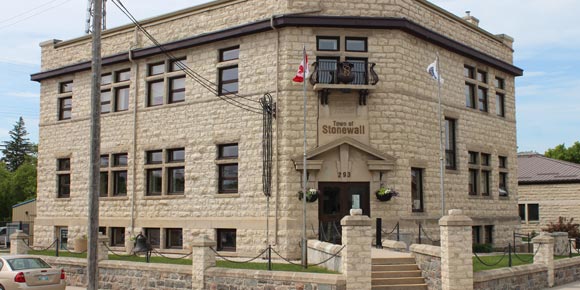The Town of Stonewall, located 25 kilometres north of Winnipeg, was founded in the late 1870s after Samuel Jackson purchased an expanse of land near some outcroppings of limestone. He established a townsite and constructed a quarry and kiln to process the stone.
Jackson’s nickname was “Stonewall”, after the American Confederate general with whom he shared a last name. He, in turn, shared that nickname with the townsite.
Stonewall was incorporated as a village in 1906 and a town in 1908.
Stonewall Quarry Park
166 Main Street
Opened in 1985, Stonewall Quarry Park is an 80-acre park and recreational site that includes an interpretive centre, arts centre, walking trails, picnic areas, a man-made lake and beach, baseball diamonds and a campground.
The park is built on an old limestone quarry that went out of operation in the late 1960s. Its owner, Winnipeg Supply and Fuel Company, donated the land for the park. Its most prominent features are the towering remnants of three kilns once used to process the stone into quicklime, a key ingredient in cement.
As the West grew, so did the demand for stone and cement. Additional quarries were created, and the region flourished.
The park’s interpretive centre, which is open daily, offers displays that tell the history of the limestone industry and the area. More about the park and its amenities can be found at: www.stonewallquarrypark.ca
Stonewall Town Hall
Main Street
In 1910, the offices of the Town of Stonewall and the R. M. of Rockwood were overcrowded, and both were in search of new premises. As a way to keep costs down, they agreed to share a newly built “inter-municipal” building on Main Street.
The parties lobbied the provincial government to have a new Land Titles Office and the county court house join them in the new building. The province eventually agreed and the four split the cost of the $26,000 structure.
The building’s architect was Victor W. Horwood. He set up his practice in Winnipeg in 1904 and was appointed Manitoba’s provincial architect in 1911. His work includes such landmarks as the U of M’s Agriculture College (now the Administration Building) and the Winnipeg Law Courts building.
Horvath’s original design for the two-storey limestone building called for a large dome atop the structure. For reasons unknown, it was not incorporated into the final plans.
The building was officially opened on July 16, 1913 by the provincial Minister of Agriculture, George Lawrence.
Notably absent from the lineup of tenants that day was a land titles office. The Roblin government was bogged down in scandal and had yet to pass legislation creating a new land titles district. A Stonewall Argus editorial a few weeks after the building’s opening called it “a miserable fiasco.”
The first major event in the building’s auditorium happened in August 1913 when a luncheon was held for a large delegation from the Winnipeg Real Estate Exchange. Town officials organized the event to show off the region and its investment opportunities.
Over time, the provincial entities moved out and in November 1985, the R.M. of Rockwood, which owned half the building but took up only around 15 per cent of the building’s space, relocated to a new building located on an adjacent lot.
The Town of Stonewall then renovated the building and in 1993 it was declared a Provincial Heritage Site.
Bank of Commerce
356 Main Street
The Bank of Hamilton opened a branch in Stonewall in 1901, initially sharing space in a commercial building on Main Street. It moved to a custom-built timber building at this location in 1907.
At around four in the morning on December 28, 1911, townspeople awoke to the sound of the bank’s fire alarm. Fire crews responded but the extreme cold rendered their pumps useless. They could only watch as the bank and its two tenants, a law firm and the county clerk’s office, were destroyed. The building’s only residents, bank manager H. A. Gray and his wife, escaped safely.
The bank’s vault and its contents were found intact the next day and a temporary branch was set up within a couple of days to serve its customers. Showing optimism in the town’s future, the Bank of Hamilton announced that it would rebuild a larger, stone building at the old location.
The architect of the new, two-storey structure was likely William Fingland. Based in Winnipeg, Fingland’s work, including several Bank of Hamilton branches, can be found throughout Manitoba and Saskatchewan. In fact, he had designed the 1907 Stonewall branch that burned down.
The Bank of Hamilton merged with the Canadian Bank of Commerce in January 1924 and took on the Commerce name. In 1961, the Commerce merged with the Imperial Bank of Canada to become the Canadian Imperial Bank of Commerce, or CIBC.
Starting in the 1960s, many banks vacated their historic branches in favour of modern buildings. In Stonewall, however, CIBC bucked the trend. In the mid-1970s, they spent over $150,000 to modernize their existing building and still call it home after more than a century.
Christian Cassidy writes about local history on his blog, West End Dumplings.



